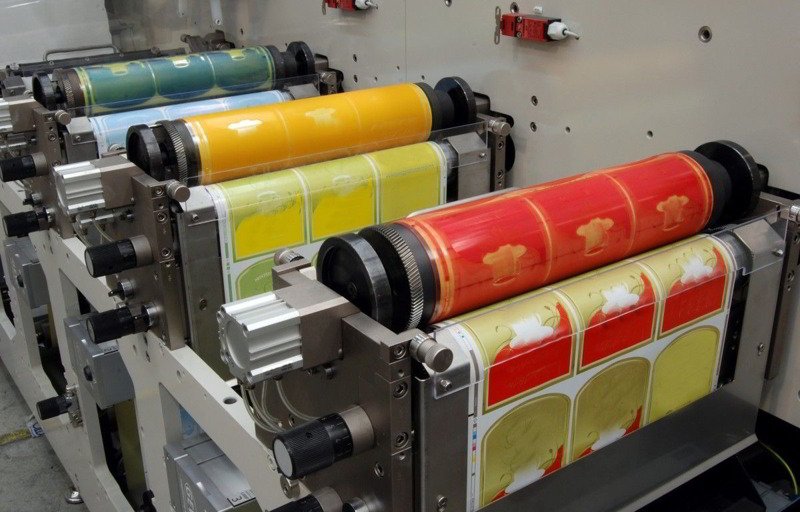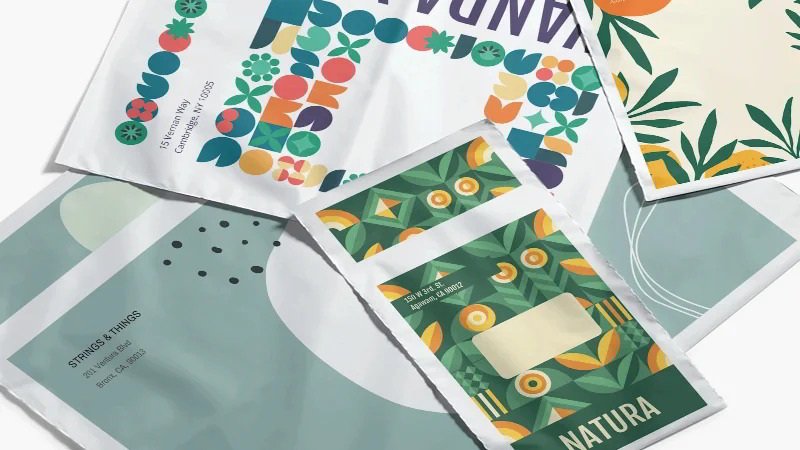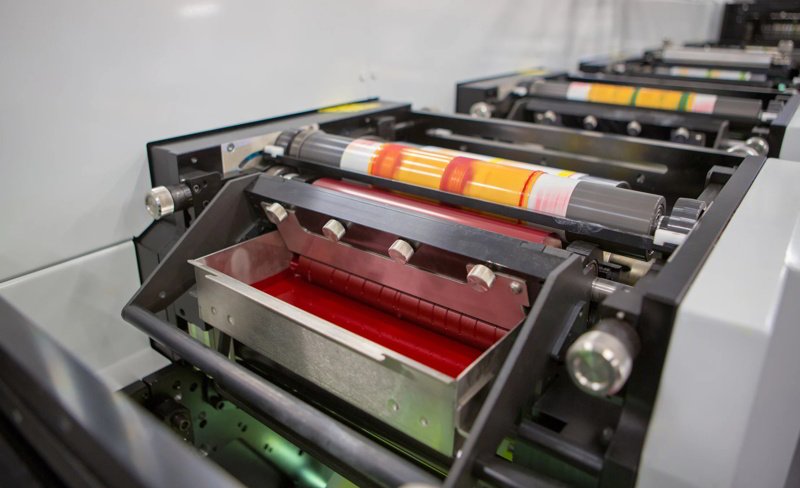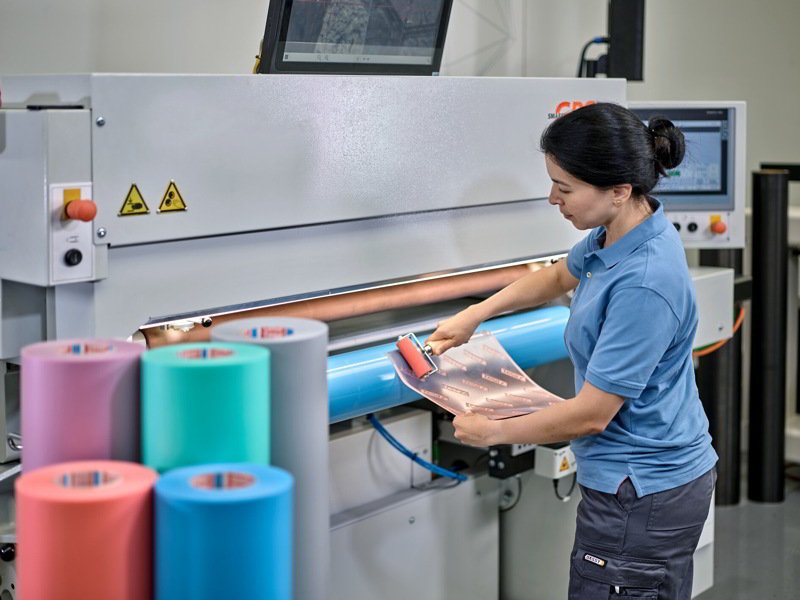Flexography: Scaling Apparel Labels & Packaging
As an apparel business grows, scaling production for labels, tags, and packaging becomes a key challenge. Methods that work for small batches often become inefficient, making it crucial to explore options like flexography. This guide explains what flexography is, how it works for apparel components, and its pros and cons, helping you decide if it’s the right strategic move for scaling your brand.
1. What exactly is flexography?
At its core, the flexography definition describes a method of rotary printing that uses a flexible relief plate to transfer ink onto a surface. Imagine a highly advanced, very fast version of using a rubber stamp – that’s the basic principle. The “flex” in flexography comes from these adaptable printing plates, typically made from photopolymer plates.
This flexibility is key because it allows the process to effectively print on a wide variety of materials, known as substrates. This includes not just paper and cardboard, but also challenging non-porous materials like the plastic films often used for poly mailers and other packaging common in the apparel industry.
Historically, flexography evolved from letterpress evolution, adapting the concept of raised image areas to work with flexible plates and faster rotary presses.

2. How flexographic printing works: From ink to finished label or bag
Understanding how flexography works involves following the path of the ink through the printing press. Here’s a breakdown of the key stages:
- Ink supply: The process begins with the ink held in a reservoir, often called an ink pan or an enclosed chamber system.
- Precise ink metering: This is where a crucial component, the anilox roller, comes into play. This is a cylinder meticulously covered with thousands of tiny engraved cells. As the anilox roller rotates through the ink source, these cells pick up the ink. Its primary function is ink metering – controlling the exact amount of ink transferred. The size and density of these cells determine the volume of ink delivered, ensuring a uniform, thin layer is passed on, which is critical for consistent print quality.
- Inking the printing plate: The precisely metered ink on the anilox roller is then transferred to the flexible plate. This plate, mounted on the plate cylinder, has the desired image raised from its surface. The ink adheres *only* to these raised areas. Often, a doctor blade lightly scrapes against the anilox roller before it contacts the plate, removing any excess ink from the non-engraved surface of the roller. This ensures a clean ink transfer to just the image areas.
- Transferring the image: The inked plate on the rotating plate cylinder then meets the material being printed. The substrate passes between the plate cylinder and another cylinder called the impression cylinder. The impression cylinder provides the necessary pressure for the inked plate to press the image cleanly onto the substrate.
- Building colors and drying: For multi-color designs, the substrate moves through a sequence of these printing stations, each applying a different color with its own plate and ink system. Flexography uses fast-drying inks – including water-based, solvent-based, or UV curing inks – allowing for very high speed printing as the material can quickly move to the next color station or be rewound without smudging.
3. Flexography in your world: Real uses for clothing brands
Flexography isn’t just an abstract printing method; it’s actively used to create many of the essential branded items apparel businesses rely on daily. Here are some common flexography applications you’ll recognize, highlighting where its strengths shine:
- Care labels and content labels: Producing those essential wash instruction and material composition labels often involves flexo. Its ability to use various durable ink options ensures prints remain legible on materials like nylon tapes, satin polyester, or coated paper tags, even after repeated washing. This makes it suitable for many types of apparel labels, especially standard care labels.
- Hang tags: For large batches of identical hang tags displaying your logo, brand name, or basic product info, flexography offers significant cost savings at scale. Printing thousands of tags on cardstock becomes very economical once the initial plates are made.
- Poly mailers and shipping bags: This is a major strength area. Flexo excels at printing directly onto the plastic films used for poly mailers. Achieving good adhesion and branding on these non-porous surfaces showcases its material versatility, making it ideal for adding logos, return addresses, or basic branding to shipping bags.
- Branded zipper bags: Similar to mailers, flexo provides consistent branding on the poly bags used for individual garment flexible packaging. If you package items like t-shirts or accessories in clear bags with your logo, flexo is likely a cost-effective method for larger quantities.
- Optional applications: While less common for direct garment printing, flexo can be used for printing simple base patterns or branding on fabrics intended for later conversion into other label types, or for branding on the corrugated boxes used for shipping bulk orders to retailers or warehouses.

4. The upside: Key advantages of using flexo printing
Understanding the mechanics of flexography leads naturally to recognizing its key benefits, particularly for businesses scaling their operations. Here are the primary advantages of flexography:
- Cost savings at scale: This is often the most significant draw for growing brands. While flexo involves initial setup costs for plates, these costs are spread across the entire order. For large print runs, the cost per label, tag, or mailer becomes significantly lower compared to digital printing, where costs are often more consistent per piece regardless of volume. The high speed printing capability also reduces labor and machine time per unit, further contributing to its cost-effective nature for bulk orders.
- High production speed and efficiency: Flexographic presses run incredibly fast, capable of producing vast quantities of printed materials in relatively short periods. This speed and efficiency are invaluable for meeting the demands of large wholesale orders or quickly replenishing inventory during peak seasons. Faster production translates to shorter lead times for repeat orders, helping businesses respond more agilely to market needs.
- Printing on diverse materials: Flexography demonstrates remarkable versatility in handling various substrates. A major advantage is its proficiency with non-porous substrates, such as the plastic films used for poly mailers, zipper bags, and other flexible packaging. Printing effectively on these surfaces can be challenging or more costly with other methods. Additionally, flexo works well on papers, corrugated cardboard, foils, and label stocks, making the process suitable for a wide range of apparel branding and packaging components.
- Ink variety and resilience: The process accommodates a broad spectrum of ink formulations, including water-based, solvent-based, and energy-curable inks like UV and EB. This allows printers to select the best ink type based on the substrate, the desired look, and specific performance requirements like washfastness for care labels, lightfastness for hang tags, or scuff resistance for mailers. This flexibility ensures the print not only looks good but also withstands the rigors of the product’s lifecycle.
- Reliable color consistency: Maintaining consistent brand colors across all materials is crucial. The precise ink metering function of the anilox roll system is fundamental to achieving reliable color consistency throughout a long print run. This system ensures a uniform ink film thickness is delivered to the plate, resulting in dependable print quality and ensuring that the first printed item looks the same as the last, reinforcing brand identity.
5. The considerations: What to keep in mind with flexo
While flexography offers compelling advantages, particularly for scale, there are practical considerations and potential disadvantages of flexography to weigh when deciding if it’s the right fit. Understanding these factors provides a balanced perspective:
- Plate costs and setup: A significant factor involves the initial setup costs. Flexography requires the creation of dedicated photopolymer plates for each color in your design. These plate costs, combined with the time needed to mount them and prepare the press, mean there’s an upfront investment before the first item is printed. This cost needs to be factored into your budget, especially for designs with multiple colors.
- Minimum order quantities (MOQs): Because of the setup involved, flexo printing is typically most cost-effective for larger runs. Printers usually establish a minimum order quantity (MOQ) to make the process economically viable. For very small batches, samples, or highly customized short runs, the setup costs can make the per-unit price unattractive compared to alternatives like digital printing, which often has minimal setup.
- Lead time for new designs: When introducing a completely new design or changing an existing one significantly, allow for additional lead time. This accounts for the time required to produce the new set of printing plates. Once the plates are made, however, subsequent repeat orders can usually be produced much faster.
- Detail nuances and dot gain: Modern flexography achieves high-quality results, suitable for the vast majority of label, tag, and packaging needs. However, it’s important to be aware of minor print quality nuances. A phenomenon called dot gain can occur, potentially affecting the sharpness of extremely fine text or intricate details compared to high-end digital printing, especially noticeable on very short runs where plate optimization might be less refined. For most standard branding applications on apparel items, this difference is often negligible, but it’s a point to consider for highly complex graphics.
- Variable data limitation: Flexography is designed for printing the same image repeatedly. It is inherently unsuited for variable data printing – situations where each label or package needs unique information printed within the same run. For such applications, digital printing is the necessary technology.

6. Flexo vs. digital printing: A practical comparison for apparel
Choosing between flexography vs digital printing depends heavily on your specific needs regarding volume, cost, materials, and design complexity. Here’s a practical comparison to help guide your decision:
| Feature | Flexography | Digital Printing |
|---|---|---|
| Best Use Case | High volume, consistent runs (thousands+) | Short runs, prototypes, variable data, quick changes |
| Setup Investment | Higher (requires plates – setup cost) | Minimal to none (no plates needed) |
| Cost per Item (Large Run) | Lower (cost per unit decreases significantly) | Generally higher, less volume discount |
| Cost per Item (Small Run) | Higher (due to setup amortization) | Lower (ideal for samples or very small batches) |
| Speed (Large Run) | Very high print speed once running | Generally slower overall throughput for large volumes |
| Printing on Plastics | Excellent, especially for poly mailers | Good, but may require specific machines/inks for adhesion |
| Design Change Flexibility | Lower (new plates needed for changes) | High (design flexibility – easy file updates) |
| Fine Detail Quality | Good to excellent (print quality), minor dot gain possible | Excellent, often sharper for intricate details/small text |
7. Is flexography the right next step for your brand?
Making the switch to a new printing technology is a significant decision. So, when to use flexography? This decision guide focuses on practical scenarios for growing apparel brands:
Flexography becomes a highly attractive option when your brand consistently requires high volume orders of the same label, tag, or packaging design. If you find yourself regularly ordering thousands, or tens of thousands, of identical items per run, the cost optimization benefits of flexo really start to shine, significantly lowering your per-unit price compared to lower-volume methods.
A strong indicator that flexo might be right for you is a significant need for branded poly mailer printing or printing on other plastic films. Flexography excels with these materials where other methods might be less reliable or more expensive. If getting your logo and return address consistently and affordably onto your shipping bags is a priority, flexo is often the most efficient solution.
Furthermore, consider the stability of your branding. If your core logo, care instructions, or mailer designs are relatively stable designs and don’t require frequent changes, the initial investment in printing plates becomes more economical over time, spread across numerous repeat orders.
Essentially, consider flexography seriously if:
- Your order quantities per design are consistently in the thousands.
- You need reliable printing on non-porous materials like poly mailers.
- Lowest cost-per-piece on high volume runs is a major goal.
- Your primary branding elements are stable and don’t change every order.
Expert Tip: Every brand’s situation is unique. The best approach is often to discuss your specific requirements – including typical run sizes, the materials you use, budget constraints, and quality expectations – with an experienced apparel packaging expert. Look for a provider knowledgeable in both flexographic and digital printing, as they can offer unbiased recommendations tailored to your brand’s stage and needs.

8. Related questions
Here are concise answers to some common questions about flexography in the context of apparel branding:
8.1 What types of inks are best for wash care labels printed with flexography?
For wash care label ink, durability is key. Options often include specially formulated resin-enhanced inks or certain UV inks known for their resistance to washing and chemicals. However, performance can vary based on the label fabric (nylon, polyester, satin) and the specific wash conditions. It is crucial to consult with your printing provider to discuss ink durability requirements and potentially conduct wash tests using the specific flexo ink types and label materials intended for your products.
8.2 How long do flexographic printing plates last?
The flexo plate lifespan depends on several factors, including the durability of the photopolymer plate, how well they are cleaned and stored, the abrasiveness of the substrate, and press operating conditions. However, well-maintained, high-quality plates can often last for hundreds of thousands, sometimes even millions, of impressions. This longevity contributes significantly to the cost-effectiveness of flexography for repeat high-volume orders.
Yes, absolutely. Flexography readily accommodates specialty flexo inks, including metallic flexo ink and vibrant fluorescent ink options. These are commonly used for hang tag printing and packaging applications to add visual impact and enhance brand appeal. Keep in mind that these specialty inks might have a different cost compared to standard process colors, so discuss this with your printer if you’re considering them.
Read more:
Flexography is a powerful printing process for growing apparel brands, offering speed, material versatility, and significant cost savings on high-volume orders of labels, tags, and poly mailers. Understanding its mechanics and weighing the pros—like high-speed production—against considerations like initial plate costs allows you to make a strategic decision for your brand.
As your brand scales, choosing the right printing partner is crucial. For expert guidance on flexographic and digital solutions tailored to your needs, contact Packlove. We help ensure your labels and packaging look professional while optimizing production costs.






















